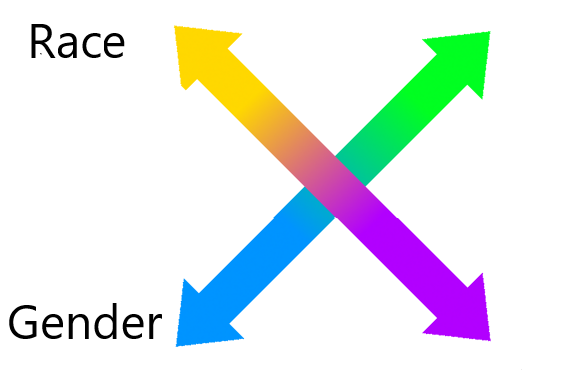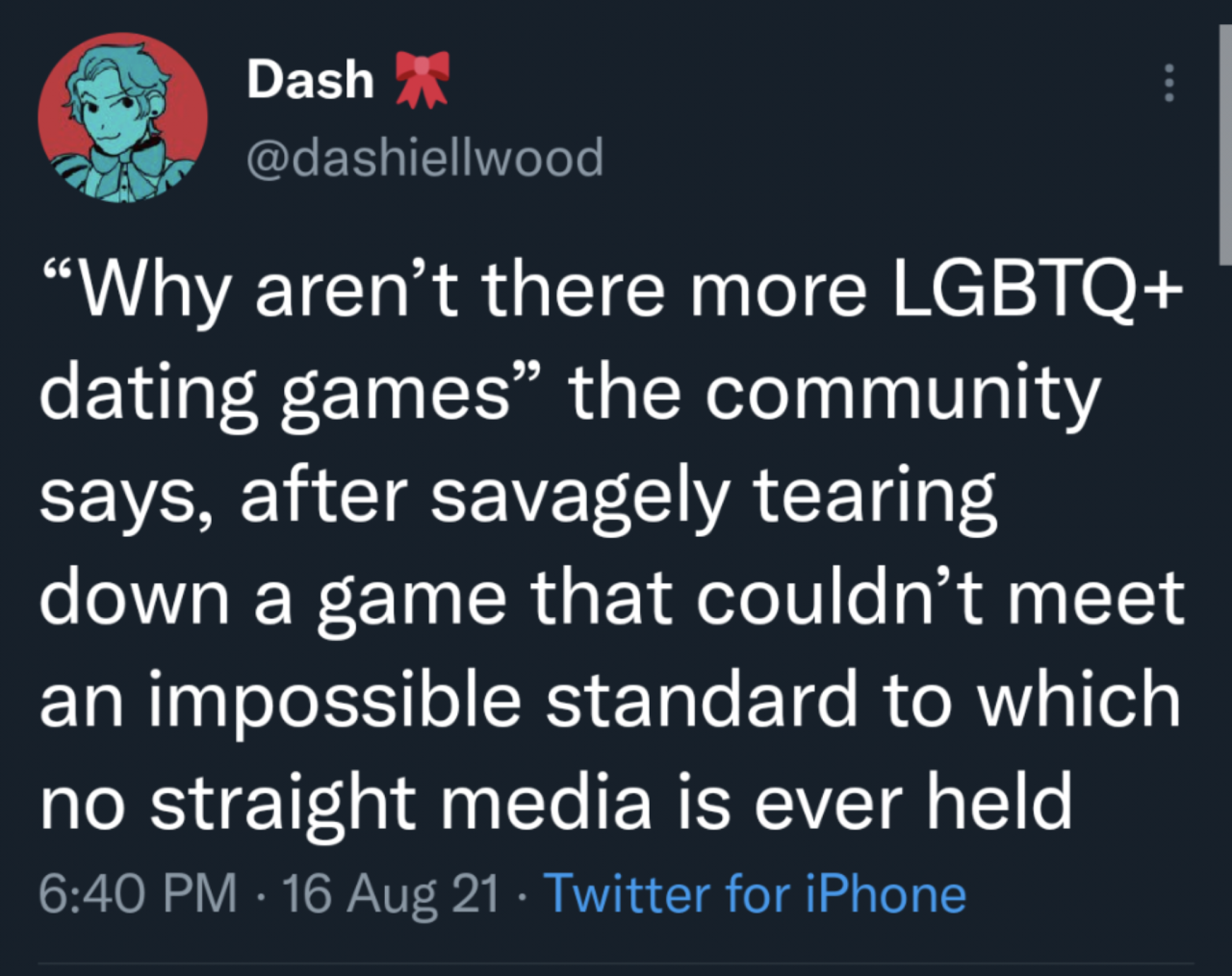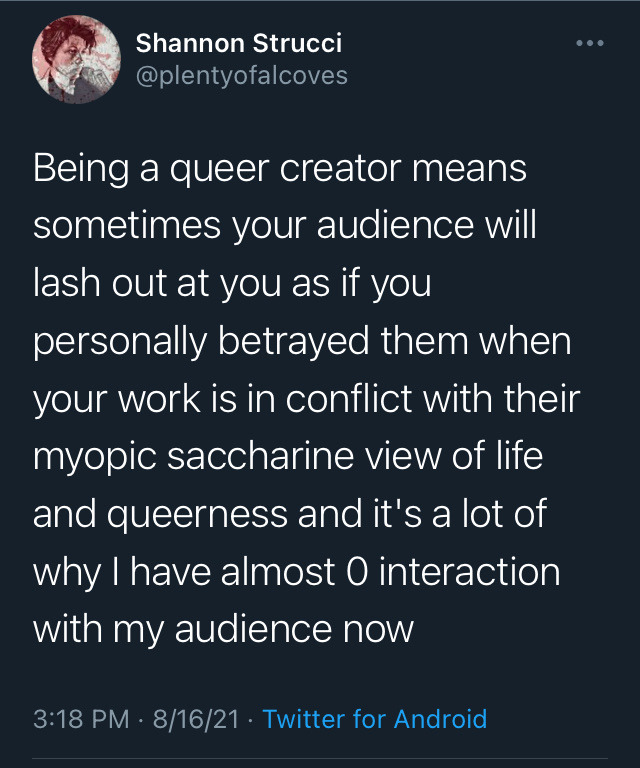@im-here-im-gay reblogged your post and added:
[…] I don’t hate the word queer for my friends, especially ones whose gender identity makes sexuality labels complicated, but I do for myself. Then again, I’m one of those 18 to 22 year old lesbians who does think radical feminism makes sense, so I guess I’m open to discussion.
Greetings! Can we interest you in some literature? Got questions about responses to radical feminism or the theories that grew from it that I do heartily agree with?
tabby-quartz replied:
i’m not the OP but if you’re open to questions (which is very cool and I appreciate it), can you recommend a starting point for someone who is at sort of a basic-level “trans inclusion is good”, “being gay is cool”, and “misogyny is bad” understanding of things and who wants to learn more about modern structural lenses but who doesn’t really have enough of a background in academic feminist or queer theory to really know where to start or how to get oriented to the discussion?
Totally! I’m gonna stick it behind the cut because I don’t want to make people on mobile scroll forever and ever and ever and I ended up with a post 2,000 words long.
This is from my friend Siderea’s essay “What Feminism Was”:
Feminism was an exploration of a problem space. Feminism was a social movement of lots of women, and not a few men, who opened up the invisible knapsack of male privilege – actually more like up-ended it on the table and rummaged its contents, going over each item, “Hmmm. What shall we do with this?”
[…] Feminism wasn’t some sort of academic process of finding the one right answer. It was an exploratory project of finding all possible answers, by what programmers call “brute-force solution”. Hundreds of thousands of people applied themselves to whatever part of the project they like, and reported back whatever answers they came up with.
Feminism was a project based on the predicate, “You know what? The answers we currently have suck. So let’s go amass all the other possible answers, answers which were never considered or were dismissed out of hand, so we can then re-evaluate them in light of what we know, and see if there isn’t some better way of organizing society.”
As such, of course different feminist perspectives conflicted. That was the point of the enterpise. This is also why back in the 80s feminists were irritatedly saying “feminism isn’t a monolith!” whenever a critic said “Feminism holds that…”
Of course, over time, feminism did hold this and that. All these possibilities were laid on the table, and some of them proved much more popular than others. For instance, our society has generally decided that women get to vote, have credit cards and mortgages in their own names, and have whatever careers work for them. Others (e.g. prostitution) we’re still arguing over.
While the main project of feminism, as it has been for the last 40 years, is done – we’ve pretty thoroughly explored the problem space, and as a result, women’s possibilities and options have been broken wide-open – that just means we’re ready for the next stage.
I don’t know what it will be called or who will do it, but I know what it has to be: the synthesizing of all those dialectics.
Because that was what feminism was, thesis vs. antithesis, times a zillion. Many of those conflicts remain to be synthesized. And that is the next stage in the liberation of women.
To explain: A dialectic is a way of looking at an argument between points of view that are contradictory, but both true. You have a thesis, a starting idea or condition, like, “Makeup is bad because the makeup industry promotes unrealistic beauty standards and discrimination against women who don’t wear makeup.” Then you have an antithesis, a counterargument, like, “Individual women aren’t responsible for what the makeup industry does, and can choose to wear makeup out of necessity or self-enjoyment.” Then you have to somehow sit down and hash it out until you get a synthesis, something that can acknowledge the realities of both points of view, like, “Individual women can wear whatever makeup they want, but we should hold companies and advertisers accountable for the messages they send.”
Of course, as soon as you get a synthesis, it turns into your new thesis, and then you can introduce an antithesis and go for another round. What about rich and powerful women who earn tons of money working as models for makeup companies and promoting unrealistic beauty standards, for instance? You can do that endlessly, in fact. Because as soon as you’ve reached your new synthesis, new considerations will pop up. In a way, the endless cycle of thesis-antithesis-synthesis is the engine that drives social progress forward.
Framing things as a dialectic is a reminder that just because two statements contradict, it doesn’t mean that you have to lock them in a cage and make them fight to the death so you know which one’s true. It’s possible they’re both true, simultaneously, and it’s by considering and synthesizing the two of them that you achieve a more nuanced, more truthful, reflection of reality.
With that in mind, let’s go back to a faraway time: The 1970s. Once upon a time, feminism came in two major tracks: Liberal feminism, and radical feminism. Radical feminism was a huge, thriving, important line of inquiry. It was diverse and amazing and important and awesome. Liberal feminism focused on the individual choices of women inside the society they lived in–getting women better educated, more financially successful, admitted to more professions, achieving outcomes more equal to men’s. Radical feminism wanted to question things at a way deeper level. For example, while liberal feminism called for more women to enter the workplace, radical feminism questioned why the workplace was the only place people could achieve social and economic prestige. Liberal feminism wanted more women in the military; radical feminism questioned why we have militaries and if wars are actually good things. It was about taking a much deeper, more critical look at society.
What we know now, 50 years later, was that of course they were both, simultaneously, valid lines of inquiry. They were thesis-antithesis that worked in tandem to create a much more powerful outcome than either of them could alone.
In the 70s, radical feminism was the preserve of both the political lesbians we were talking about at the beginning of this discussion, and lesbians who were just gay because they fell in love with women without any larger political consideration, and a ton of other people besides. It was a huge tent. But as time wore on, a few things happened that pulled groups of people away from radical feminism. The radical feminism of 2019 is in some ways a ghost town whose former inhabitants have all moved somewhere else, except for a few holdouts who want to consider sex discrimination the only form of oppression truly worth considering. People didn’t leave for radical feminism’s rival, liberal feminism, but the dialectic’s synthetic children, the new communities that were created as new answers to the old debate. The Second Wave of feminism, radfem vs libfem, ended, and the Third Wave, the messy, multivocal, many-stranded, often frankly confusing and hard-to-navigate new era, began.
One synthesis: When the AIDS crisis hit in the 1980s and social discrimination against homosexuality became more acute, many women who loved women decided they had more in common with the interests of gay men and trans people, other groups similarly affected by both AIDS and its social backlash, than they did with political lesbians who wanted to cut men and trans people out of their lives completely. So the LGBT+ community, which had never been on entirely good terms with political lesbians who were leading lights of the radical feminist world, pulled away rather more definitively; they couldn’t consider misogyny the only important oppression, because there was a much bigger and messier network of expectations about sex and gender that weren’t just trying to oppress women. That’s where you get new approaches like queer theory. For a really accessible guide, try Queer: A Graphic History by Meg-John Barker and Julia Scheele.
Another synthesis: Black radical feminists felt themselves pulled in opposite directions, between race and gender. Feminism tended to centre the voices, experiences, and concerns of white women. For example, a major feminist push was to “liberate” women from the expectation that they be stay-at-home wives completely devoted to their children, which was absolutely the experience of many white women in 1960s America–but on the other hand, Black women had always been compelled to work outside the home, usually in menial jobs as cooks, maids, or nannies; when white women worked outside the home, they often did so by hiring a Black woman to take over the cleaning and childcare–and Black women often felt that they would like the privilege of being able to stay home and devote more time to their families.
Black feminists especially grew increasingly uneasy with radical feminism’s contention that sex difference was the most important bias in the world, the root of all others; they found that even in all-women spaces, even in lesbian communes, their white sisters still perpetrated racial discrimination against them. Also, they found that sometimes feminist initiatives worked to the positive detriment of Black people; white feminists who fought rape culture often did so by villainizing young Black men to an extent that was inaccurate, unfair, and oppressive. Both ideologically, and in lived experience, Black feminists found that even though their feminism was vital and important, it was insufficient.
The texts I’d suggest for this are Audre Lorde’s Sister Outsider and Feminism is for Everybody by bell hooks–both Black women who were avid radical feminists, and worked inside the movement until they developed a level of understanding and method of activism that actually transcended it.
The synthesis Black feminists came up with was that oppression cannot be thought of as a single up-or-down situation where you only have to look at one set of characteristics about a person to see who’s on top. There are, in fact, multiple oppressions far beyond sex. Each oppression is its own axis (think axel, a long stick on which important things turn). These axes of oppression were often pretty distinct and independent, but they did intersect, and really unique and unexpected things happen at the places they run into each other.

Therefore, a lot of Black radical feminists moved forward into Intersectional Feminism, and a lot of other radical feminists joined them there. A lot of everybody joined them there, honestly, because it’s a model that has incredible value for many, many fields. Once you open up the idea that oppression isn’t just based on sex, that there are multiple axes, suddenly you realize that there are a LOT of power systems oppressing people in the world. Like, HOLY SHIT OMG. There’s sex, race, class, sexual orientation, gender expression, disability, religion, age… you name it. I’m not yet at the point where I’d feel comfortable trying to explain North American Indigenous feminism, for example, but seeing social justice from an Indigenous point of view means absolutely upending a lot of basic Western assumptions about what oppression actually is. The more you look for different axes, perspectives, and marginalized groups, the more you find.

It’s not actually ironic that the diagram I made to illustrate multiple intersecting axes is also, in occult symbology, the symbol of chaos. Intersectionality is a multifaceted and powerful way of looking at problems, but its failing is that it can get so complicated, so granular, that it’s really hard to hold all the many contradictory but simultaneously true threads of argument in your head and arrive at any sort of conclusion. Intersectionality turns the dialectic process from two competing arguments into an infinite number of competing arguments. If the process is actually performed with an adequate supply of good information, deep knowledge, good faith, open communication, tolerance for ambiguity, and humility about the outcome, it produces really amazing, top-notch social analysis and activism.
However, the failure mode of intersectionality is–remember when I said dialectics wasn’t just locking two arguments in a cage and letting them fight it out to see who wins? That’s what a lot of people think it is. When these arguments turn into “Who’s right?”–and in the age of social media cancel culture, they really mostly do–intersectionality gets misinterpreted as a Battle Royale, and oppressions as weapons for stockpiling. People think that the more axes you’re oppressed on, the more weapons you have! Arguments are declared “won” not based on their actual content so much as the beginning oppression stats of the people having them. This is a failure mode, not how the system’s actually supposed to work.
(This feels like a good time to link to Angie Speaks’ video Social Justice Can Be a Clout Game: Here’s How to Avoid It)
And those are just TWO examples of synthesis movements that sprung out of radical feminism and took on a life of their own. There are many more. Postcolonial feminism! Male feminism! Chicana feminism! Crip feminism! Part of why it’s so hard to get a grip on who’s who and what the arguments are in the modern day is just because there are so MANY of them, and as soon as somone can write a guidebook to the current scene, things change AGAIN. There’s actually been an entirely new wave, the fourth, where feminists from countries like India and China found their own way of mobilizing, that I am in no way equipped to actually explain.
In some ways the current ghost town of radical feminism being overrun by transphobes saddens me, because in that town’s booming heyday, it was an awesome place. So many amazing, historical things happened there. And a lot of people might come back to it to dwell on fond memories–but the current inhabitants keep chucking rocks at them.
I find it really telling that modern transphobes tend not to even acknowledge the existence of modern descendant groups to radical feminism. They stay fixated on “liberal feminism”, that old enemy, the necessary antithesis to their thesis, because it lets old radical feminism stay intact. The newer schools of thought are more effective counterarguments, because they aren’t counterarguments, they’re upgrades. They’re like, “Cool starting principles, neat ideas, but I strapped a rocket pack to them and added some titanium shark fins, wanna go see me try them out in the desert?” and if the TERFs’ young audience heard that, I think a lot of them would move on.







